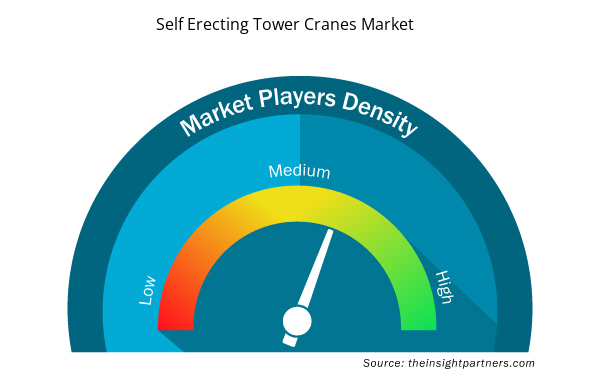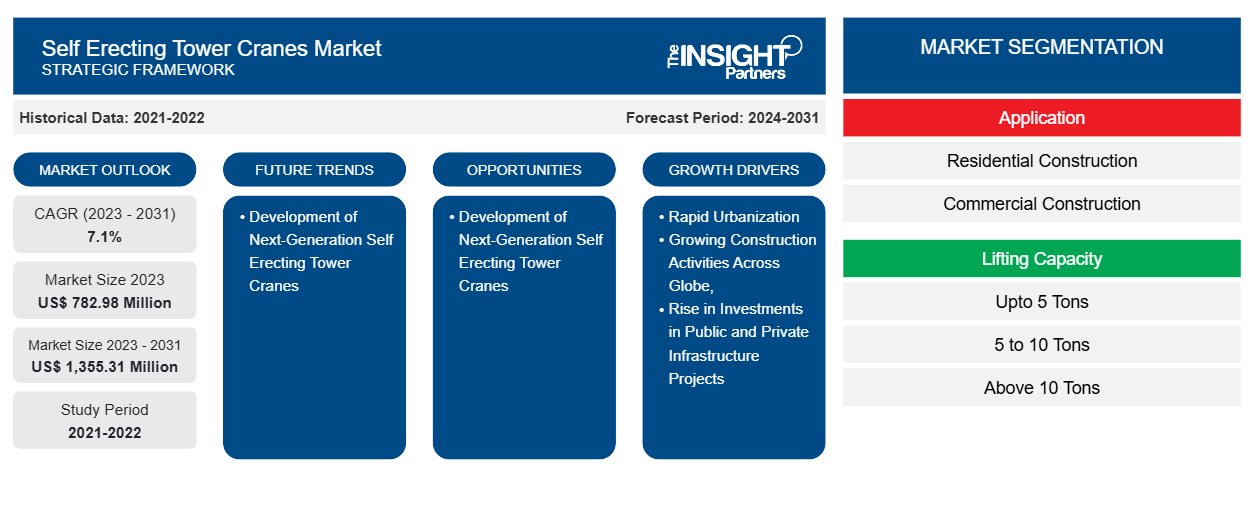自立式タワークレーン市場は、2023年の7億8,298万米ドルから成長し、2031年までに13億5,531万米ドルに達すると予測されています。市場は2023年から2031年の間に7.1%のCAGRを記録すると予想されています。
自立式タワークレーン市場の主要企業は、建設現場での顧客の要件を満たすために高度な技術を開発し、採用しています。企業は遠隔地のユーザーに柔軟性を提供するためにテレマティクスソリューションを有効にしています。2024年1月、タワークレーンメーカーのPotainは、容量4トンのEvy 30-23自立式クレーンモデルに基づく最新の高度な技術を発表しました。自立式クレーンのシリーズは、顧客の声の開発プロセスを使用して設計されています。また、同社は、新しいシリーズがタワークレーンの欧州安全規格EN 14439に準拠していると主張しています。
自立式タワークレーン市場分析
アジアの建設業界は著しい成長率で成長しています。アジア開発銀行によると、アジア太平洋諸国は建設部門に年間約 1.7 兆米ドルを投資しています。住宅建設プロジェクトの需要増加と公共部門の急速なインフラ開発により、建設部門は急速に成長しています。このような開発により、自立式タワークレーンの需要は著しい割合で増加しています。
自立式タワークレーン市場の概要
自立式タワークレーンにはキャビンがなく、遠隔操作が可能です。このクレーンは自己完結型で追加のクレーンが不要なため、小規模から中規模の建設プロジェクトでよく使用されます。自立式タワークレーンの需要が高まっている主な要因の1つは、都市化の進行と建設活動の増加です。都市化により、土地が住宅、商業、工業、輸送用に転用されます。2022年12月に米国国勢調査局が提供した都市部の最新リストによると、米国の都市人口は2010年から2023年の間に6.9%増加しました。米国西部は、2022年時点で住民の88.9%が都市に住んでおり、国内の4つの国勢調査地域の中で最も都市化が進んでいます。次いで北東部が84.0%となっています。米国以外では、スペインでも都市化が顕著に進んでいます。
要件に合わせてレポートをカスタマイズする
このレポートの一部、国レベルの分析、Excelデータパックなど、あらゆるレポートを無料でカスタマイズできます。また、スタートアップや大学向けのお得なオファーや割引もご利用いただけます。
- このレポートの主要な市場動向を入手してください。この無料サンプルには、市場動向から見積もりや予測に至るまでのデータ分析が含まれます。
自立式タワークレーン市場の推進要因と機会
公共および民間インフラプロジェクトへの投資の増加
都市部と農村部では、いくつかの国の政府による建設活動への投資が増加しています。世界銀行の報告書によると、2022年には、インド、中国、日本、アフリカなどすべての低中所得国で、民間セクターの263のインフラプロジェクトに917億米ドルが投資されました。これは、2017年から2021年の平均成長率4%と比較して、2022年は2021年と比較して23%の成長を示しています。2022年には、COVID-19パンデミック後の投資コミットメントが増加し、開発途上国の建設活動が大幅に回復しました。
スマートシティの取り組みの増加
スマートシティプロジェクトは、より効率的で効果的なユーティリティインフラへの移行に重点を置いています。スマートシティ開発プロジェクトでは、タワークレーン、自立式クレーン、その他の高度な建設機械を使用して、資材の取り扱いを最適化します。自立式クレーンの使用は、運用効率の向上、エネルギー使用量と支出の削減に役立ち、積極的な意思決定につながります。Smart Americaによると、2022年6月、米国の市政府は、今後20年間でインフラのアップグレードとIoTソリューションの実装に約41兆米ドルを投資する計画を発表しました。また、欧州連合委員会のホライズンヨーロッパの目標は、2030年までに100の都市を気候中立でスマートなものにすることを目指しています。∼US$ 41 trillion in infrastructure upgrades and the implementation of
自立式タワークレーン市場レポートのセグメンテーション分析
自立式タワークレーン市場分析の導出に貢献した主要なセグメントは、アプリケーションと容量です。
- 用途に基づいて、自立式タワークレーン市場は住宅建設、商業建設、その他に分類されます。住宅セグメントは2023年に最大の市場シェアを占めました。
- 持ち上げ能力によって、市場は5トンまで、5〜10トン、10トン以上に分割されます。
地域別自立式タワークレーン市場シェア分析
自立式タワークレーン市場レポートの地理的範囲は、主に北米、アジア太平洋、ヨーロッパ、中東およびアフリカ、南米の 5 つの地域に分かれています。
ヨーロッパは、小規模住宅の建設需要の増加と橋梁、道路、高速道路の建設活動の急増により、2023年に最大の自立式クレーン市場シェアを記録しました。ドイツ貿易投資振興機関(GTAI)のデータによると、ドイツは最大の建設市場を持ち、2020年の収益は1,750億米ドルでした。さらに、ドイツ政府の住宅建設への取り組みにより、国内の自立式クレーンの需要が高まっています。2024年には、ドイツ政府は年間40万戸のアパートを建設するという目標を設定しました。住宅建設に加えて、インフラ開発への投資が自立式クレーン市場の成長を後押ししています。
自立式タワークレーン市場のニュースと最近の動向
自立式タワークレーン市場は、主要な企業出版物、協会データ、データベースを含む一次調査と二次調査後の定性的および定量的データを収集することによって評価されます。以下は、自立式タワークレーン市場における開発と戦略のリストです。
- Terex のセルフエレクティング クレーンは、Kranlyft UK を英国とアイルランドの正規代理店に任命したことを発表しました。Kranlyft UK は、最新の CSE シリーズやヨーロッパで唯一のセルフエレクティング トップ旋回クレーンであるユニークな FC 6.24 を含む Terex のセルフエレクティング クレーンの全製品群を、販売、サービス、部品サポートとともに即時提供します。(出典: Terex Corp.、プレス リリース/会社 Web サイト/ニュースレター、2023 年)
- 大手タワークレーンブランドの Potain は、新型自立式クレーン Evy 30-23 4 t を発表しました。この新モデルは、Potain 自立式クレーンの最新世代である Evy シリーズのデビューを飾るものであり、顧客の声に基づく製品開発プロセスと、シンプルさとフック下の高さの増加を求める市場の要求に基づいて設計され、タワークレーンの更新された欧州安全規格 EN 14439 に準拠しています。(出典: Potain Group、プレスリリース/会社 Web サイト/ニュースレター、2023 年)
自立式タワークレーン市場の地域別分析
予測期間を通じて自立式タワークレーン市場に影響を与える地域的な傾向と要因は、Insight Partners のアナリストによって徹底的に説明されています。このセクションでは、北米、ヨーロッパ、アジア太平洋、中東、アフリカ、南米、中米にわたる自立式タワークレーン市場のセグメントと地理についても説明します。

- 自立式タワークレーン市場の地域別データを入手
自立式タワークレーン市場レポートの範囲
| レポート属性 | 詳細 |
|---|---|
| 2023年の市場規模 | 7億8,298万米ドル |
| 2031年までの市場規模 | 13億5,531万米ドル |
| 世界のCAGR(2023年~2031年) | 7.1% |
| 履歴データ | 2021-2022 |
| 予測期間 | 2024-2031 |
| 対象セグメント | アプリケーション別
|
| 対象地域と国 | 北米
|
| 市場リーダーと主要企業プロフィール |
|
自立式タワークレーン市場のプレーヤー密度:ビジネスダイナミクスへの影響を理解する
自立式タワークレーン市場は、消費者の嗜好の変化、技術の進歩、製品の利点に対する認識の高まりなどの要因により、エンドユーザーの需要が高まり、急速に成長しています。需要が高まるにつれて、企業は提供を拡大し、消費者のニーズを満たすために革新し、新たなトレンドを活用し、市場の成長をさらに促進しています。
市場プレーヤー密度とは、特定の市場または業界内で活動している企業または会社の分布を指します。これは、特定の市場スペースに、その規模または総市場価値と比較して、どれだけの競合相手 (市場プレーヤー) が存在するかを示します。
自立式タワークレーン市場で事業を展開している主要企業は次のとおりです。
- リープヘルインターナショナルAG
- マニトワック株式会社
- テレックス株式会社
- FMGru srl
- グルアス・サエス
- SL
免責事項:上記の企業は、特定の順序でランク付けされていません。

- 自立式タワークレーン市場のトップキープレーヤーの概要を入手
自立式タワークレーン市場レポートの対象範囲と成果物
「自立式タワークレーン市場規模と予測(2023〜2031年)」レポートでは、以下の分野をカバーする市場の詳細な分析を提供しています。
- 対象範囲に含まれるすべての主要市場セグメントの世界、地域、国レベルでの市場規模と予測
- 市場の動向(推進要因、制約、主要な機会など)
- 今後の主な動向
- 詳細なPESTおよびSWOT分析
- 主要な市場動向、主要プレーヤー、規制、最近の市場動向を網羅した世界および地域の市場分析
- 市場集中、ヒートマップ分析、主要プレーヤー、最近の動向を網羅した業界の状況と競争分析
- 詳細な企業プロフィール
- 過去2年間の分析、基準年、CAGRによる予測(7年間)
- PEST分析とSWOT分析
- 市場規模価値/数量 - 世界、地域、国
- 業界と競争環境
- Excel データセット



Report Coverage
Revenue forecast, Company Analysis, Industry landscape, Growth factors, and Trends

Segment Covered
This text is related
to segments covered.

Regional Scope
North America, Europe, Asia Pacific, Middle East & Africa, South & Central America

Country Scope
This text is related
to country scope.
よくある質問
Urbanization results in the conversion of land for residential, commercial, industrial, and transportation use. According to the updated list of urban areas provided by the United States Census Bureau in December 2022, urban population in the US increased by 6.9% between 2010 and 2023. The West region of the US remained the most urban of the country's four census areas, with 88.9% of its inhabitants living in cities, followed by the Northeast region with 84.0% as of 2022. Apart from the US, Spain has also witnessed a notable rise in urbanization. According to United Nations in 2023, 82.0% of the population lived in cities. With a rapidly increasing urban population, the construction sector is growing at a rapid pace. Small-scale construction activities are upsurging across the world. The self-erecting cranes play a vital role in fulfilling the demands for housing, lighting issues resolution, residential construction activities, and others.
Smart city projects focus on the transition to a more efficient and effective utility infrastructure. Smart city development projects use tower cranes, self-erecting cranes, and other advanced construction equipment to optimize material handling. The use of self-erecting cranes helps increase operational efficiency, reduces energy usage and expenditures, and leads to proactive decision-making. According to Smart America, in June 2022, city governments in the US announced their plan to invest ∼US$ 41 trillion in infrastructure upgrades and the implementation of Internet of Things solutions over the next 20 years. Also, the European Union Commission's Horizon Europe objective aims to transform 100 cities into climate-neutral and smart by 2030.
Key players in the self-erecting cranes market are developing and adopting advanced technologies to meet the customer's requirements at construction sites. Companies are enabling telematic solutions to offer flexibility for users at remote locations. In January 2024, the Potain tower crane manufacturer launched brand-new advanced technologies based on the Evy 30-23 self-erecting crane model with a capacity of 4 tons. The range of self-erecting cranes is designed with the Voice of the Customer development process.
Liebherr International AG, The Manitowoc Co Inc., Terex Corp., FMGRU SRL, Gruaz Saez S.L, Tavol Cranes Group, and ACE. are the key market players operating in the global self erecting tower crane market.
Trends and growth analysis reports related to Manufacturing and Construction : READ MORE..
The List of Companies - Self Erecting Tower Cranes Market
- Liebherr International AG
- The Manitowoc Co Inc.
- Terex Corp.
- FMGru srl
- Gruas Saez S.L
- Gru Dalbe srl
- Tavol Cranes Group Co.,ltd
- Dawson Group Ltd.
- P&J Acromet
- Action Construction Equipment Limited
The Insight Partners performs research in 4 major stages: Data Collection & Secondary Research, Primary Research, Data Analysis and Data Triangulation & Final Review.
- Data Collection and Secondary Research:
As a market research and consulting firm operating from a decade, we have published and advised several client across the globe. First step for any study will start with an assessment of currently available data and insights from existing reports. Further, historical and current market information is collected from Investor Presentations, Annual Reports, SEC Filings, etc., and other information related to company’s performance and market positioning are gathered from Paid Databases (Factiva, Hoovers, and Reuters) and various other publications available in public domain.
Several associations trade associates, technical forums, institutes, societies and organization are accessed to gain technical as well as market related insights through their publications such as research papers, blogs and press releases related to the studies are referred to get cues about the market. Further, white papers, journals, magazines, and other news articles published in last 3 years are scrutinized and analyzed to understand the current market trends.
- Primary Research:
The primarily interview analysis comprise of data obtained from industry participants interview and answers to survey questions gathered by in-house primary team.
For primary research, interviews are conducted with industry experts/CEOs/Marketing Managers/VPs/Subject Matter Experts from both demand and supply side to get a 360-degree view of the market. The primary team conducts several interviews based on the complexity of the markets to understand the various market trends and dynamics which makes research more credible and precise.
A typical research interview fulfils the following functions:
- Provides first-hand information on the market size, market trends, growth trends, competitive landscape, and outlook
- Validates and strengthens in-house secondary research findings
- Develops the analysis team’s expertise and market understanding
Primary research involves email interactions and telephone interviews for each market, category, segment, and sub-segment across geographies. The participants who typically take part in such a process include, but are not limited to:
- Industry participants: VPs, business development managers, market intelligence managers and national sales managers
- Outside experts: Valuation experts, research analysts and key opinion leaders specializing in the electronics and semiconductor industry.
Below is the breakup of our primary respondents by company, designation, and region:

Once we receive the confirmation from primary research sources or primary respondents, we finalize the base year market estimation and forecast the data as per the macroeconomic and microeconomic factors assessed during data collection.
- Data Analysis:
Once data is validated through both secondary as well as primary respondents, we finalize the market estimations by hypothesis formulation and factor analysis at regional and country level.
- Macro-Economic Factor Analysis:
We analyse macroeconomic indicators such the gross domestic product (GDP), increase in the demand for goods and services across industries, technological advancement, regional economic growth, governmental policies, the influence of COVID-19, PEST analysis, and other aspects. This analysis aids in setting benchmarks for various nations/regions and approximating market splits. Additionally, the general trend of the aforementioned components aid in determining the market's development possibilities.
- Country Level Data:
Various factors that are especially aligned to the country are taken into account to determine the market size for a certain area and country, including the presence of vendors, such as headquarters and offices, the country's GDP, demand patterns, and industry growth. To comprehend the market dynamics for the nation, a number of growth variables, inhibitors, application areas, and current market trends are researched. The aforementioned elements aid in determining the country's overall market's growth potential.
- Company Profile:
The “Table of Contents” is formulated by listing and analyzing more than 25 - 30 companies operating in the market ecosystem across geographies. However, we profile only 10 companies as a standard practice in our syndicate reports. These 10 companies comprise leading, emerging, and regional players. Nonetheless, our analysis is not restricted to the 10 listed companies, we also analyze other companies present in the market to develop a holistic view and understand the prevailing trends. The “Company Profiles” section in the report covers key facts, business description, products & services, financial information, SWOT analysis, and key developments. The financial information presented is extracted from the annual reports and official documents of the publicly listed companies. Upon collecting the information for the sections of respective companies, we verify them via various primary sources and then compile the data in respective company profiles. The company level information helps us in deriving the base number as well as in forecasting the market size.
- Developing Base Number:
Aggregation of sales statistics (2020-2022) and macro-economic factor, and other secondary and primary research insights are utilized to arrive at base number and related market shares for 2022. The data gaps are identified in this step and relevant market data is analyzed, collected from paid primary interviews or databases. On finalizing the base year market size, forecasts are developed on the basis of macro-economic, industry and market growth factors and company level analysis.
- Data Triangulation and Final Review:
The market findings and base year market size calculations are validated from supply as well as demand side. Demand side validations are based on macro-economic factor analysis and benchmarks for respective regions and countries. In case of supply side validations, revenues of major companies are estimated (in case not available) based on industry benchmark, approximate number of employees, product portfolio, and primary interviews revenues are gathered. Further revenue from target product/service segment is assessed to avoid overshooting of market statistics. In case of heavy deviations between supply and demand side values, all thes steps are repeated to achieve synchronization.
We follow an iterative model, wherein we share our research findings with Subject Matter Experts (SME’s) and Key Opinion Leaders (KOLs) until consensus view of the market is not formulated – this model negates any drastic deviation in the opinions of experts. Only validated and universally acceptable research findings are quoted in our reports.
We have important check points that we use to validate our research findings – which we call – data triangulation, where we validate the information, we generate from secondary sources with primary interviews and then we re-validate with our internal data bases and Subject matter experts. This comprehensive model enables us to deliver high quality, reliable data in shortest possible time.


 このレポートの無料サンプルを入手する
このレポートの無料サンプルを入手する